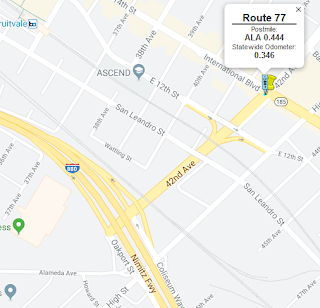Over the last two weeks I visited almost every State Highway in the San Francisco Bay Area. The shortest State Highway by a large margin in the Bay Area is California State Route 77.
CA 77 is presently only 0.45 miles in length and is located entirely within the City of Oakland. CA 77 begins at Interstate 880 and heads eastward on 42nd Avenue to CA 185 on 14th Street.
As presently completed CA 77 would rank as the fourth shortest State Highway only behind CA 225, CA 275 and CA 283.
CAhighways.org list of Shortest State Highways
CA 77 presently has a 13.4 mile portion that has not been constructed. CA 77 as originally envisioned would have continued northeast towards Concord and would have junctions with; I-580, unbuilt CA 93, CA 24, I-680 and CA 242. According to CAhighways.org the present route of CA 77 was designated as Legislative Route Number 233 which was approved by the State Legislature in 1953. The legislative description of LRN 233 was changed to LRN 235 by 1957.
CAhighways.org on CA 77
CAhighways.org on LRN 235
The path of LRN 233 first appears on the 1954 State Highway Map City Insert.
The designation of LRN 235 replaces LRN 233 on the 1958 State Highway Map City Insert.
By 1963 the portion of LRN 235 between CA 17 on the Nimitz Freeway (current I-880) and LRN 105 (present CA 185) is shown completed.
During the 1964 State Highway Renumbering LRN 235 was reassigned as CA 77.
According to CA 77 the planned route of CA 77 was cut back to CA 24 in Layayette by 1975. This is reflected on the 1977 State Highway Map City Insert.
Note; as completed in 1963 the configuration of LRN 235/CA 77 was a freeway with free flowing ramps to/from CA 17/I-880 northbound. Said ramps were reconfigured in 2012 into the at-grade ramps present at the western terminus of CA 77.
Access to CA 77 can be obtained from I-880 via Exit 38. Oddly High Street is signed from I-880 and not 42nd Avenue even though that is the direct connection. From I-880 there is not CA 77 signage, the downpour was about as miserable as it looks.
From the exit ramp CA 77 begins with a left hand turn onto 42nd Avenue. Again there is no CA 77 shields to be found.
CA 77 east travels under both travel lanes of I-880 and essentially is limited access (albeit not a freeway).
Between the northbound lanes of I-880 and on-ramp from Coliseum Way the first CA 77 reassurance shield appears. CA 77 east even features an off-ramp to 12th Street which can be seen in the second photo below.
The CA 77 reassurance shield makes it the real "shortest" signed State Highway and not CA 153 which is often proclaimed as such. My previous blog entry on CA 153 can be found below.
California State Route 153; the supposedly shortest State Highway
CA 77 east even has a second reassurance shield before it terminates at CA 185 at 14th Street.
















Comments
Littledots@yahoo.com